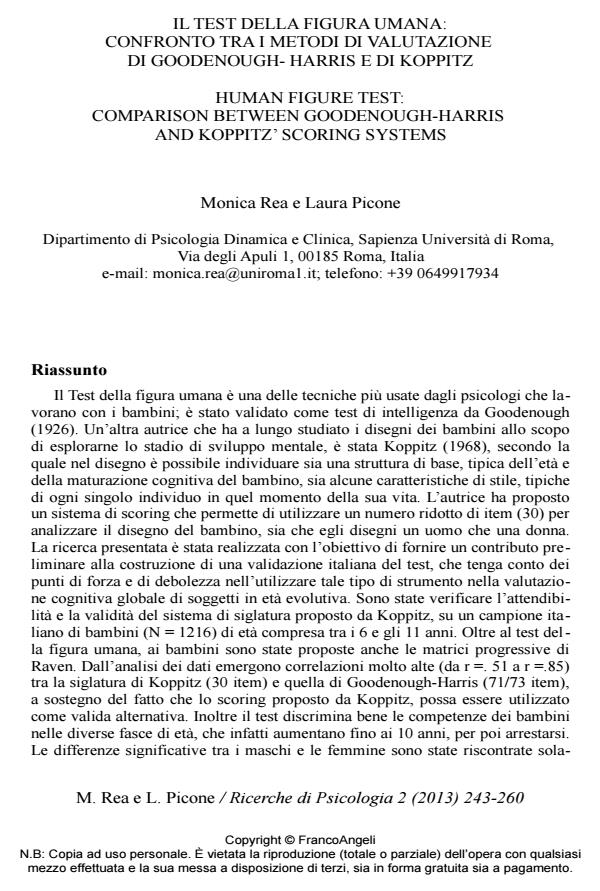Comparison between Goodenough-Harris and Koppitz’ scoring systems
Journal title RICERCHE DI PSICOLOGIA
Author/s Monica Rea, Laura Picone
Publishing Year 2013 Issue 2013/2
Language Italian Pages 18 P. 243-260 File size 238 KB
DOI 10.3280/RIP2013-002002
DOI is like a bar code for intellectual property: to have more infomation
click here
Below, you can see the article first page
If you want to buy this article in PDF format, you can do it, following the instructions to buy download credits

FrancoAngeli is member of Publishers International Linking Association, Inc (PILA), a not-for-profit association which run the CrossRef service enabling links to and from online scholarly content.
The human figure test is one of children evaluation system used by psychologists. It was validated by Goodenough (1926) as a intelligence test. Later, Koppitz (1968) studied children’s drawings, in order to explore their mental stage. She believed that through drawings was possible to identify both cognitive maturation of children, and typical characteristics of a specific age. The author proposed a scoring system with a reduced number of items (30), used to analyze the drawings, when the child draws man that a woman. The present study want to verify the reliability and validity of the scoring system proposed by Koppitz, in Italian children (N = 1216) from 6 to 11 years. Also, the subjects were also assessed with Raven Progressive Matrices. Analysis of data shows very high correlations (from r = .51 to r = .85) between two evaluation systems, by Koppitz (30 items) and by Goodenough-Harris (71/73 items), supporting the fact that the scoring proposed by Koppitz can be used as a valid and faster alternative. Furthermore, human figure test discriminates skills of children in different age. In fact, scores increase from six to ten years, and then stop. Significant differences have been found between males and females only in woman figure draw. There were not found high correlations between human figure test and Raven Progressive Matrices, confirming the fact that this test provide an adaptation index of development and of conceptual maturation, and not an index of cognitive development. Therefore, is important to use this test only as first screening of cognitive maturation. If a child obtains a score below the average for its age group, are necessary a clinical evaluation and an assessment with more valid intelligence tests.
Keywords: Human figure test, Koppitz’ scoring system, cognitive assessment, developmental assessment.
Monica Rea, Laura Picone, Il test della figura umana: confronto tra i metodi di valutazione di goodenough- harris e di koppitz human figure test: in "RICERCHE DI PSICOLOGIA " 2/2013, pp 243-260, DOI: 10.3280/RIP2013-002002